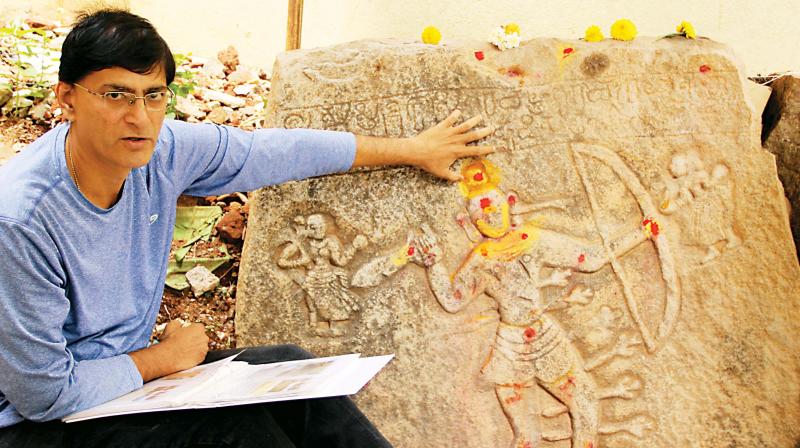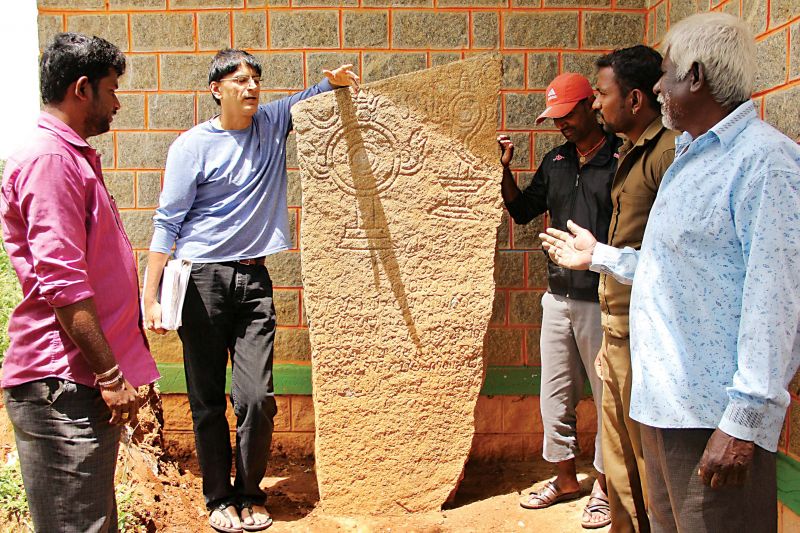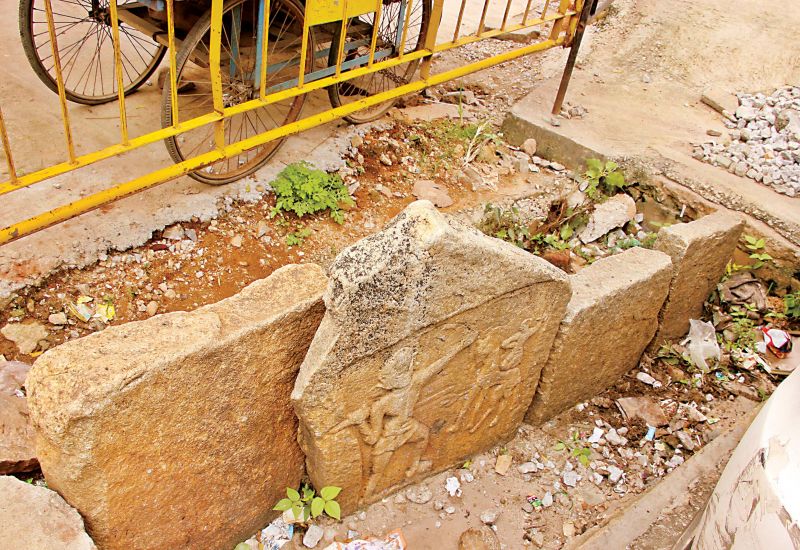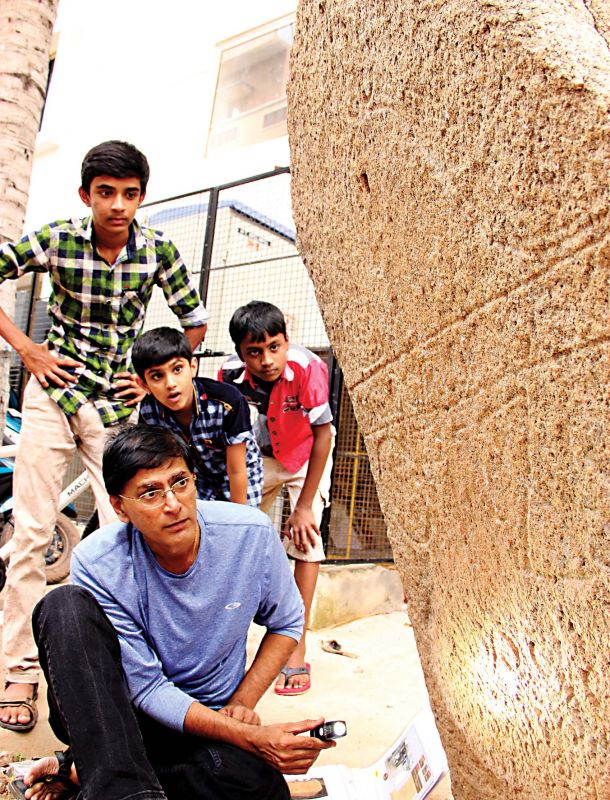Bengaluru buzzed even in 750 AD!
There were four in Dasarahalli and only two remain. Two were destroyed by a resident who wanted to use the stone, said Kumar,

History doesn’t always spring to mind in connection with the IT hub, but Bengaluru is rife with it. Inscriptions that trace Bengaluru’s history back to the 8th century A.D. lie forgotten across the city. Clearly, Bengaluru was in business long before the 16th century! History buff Udaya Kumar’s chance discovery of an inscription where he lived led him to trace the rest. He tells Darshana Ramdev about the extraordinary wealth of heritage that stands on the brink of being lost for good...
Bengaluru: Could Bengaluru have been a bustling township as far back as the 8th century? If the inscriptions that lie scattered across the city are anything to go by, it well might have been. And in Bengaluru's rapidly changing urbanscape, there are few things as exciting as stumbling upon a bit of history. “We tend to look everywhere but our immediate surroundings," remarked Udaya Kumar P.L., an engineer with a fascination for history, which has led him to often overlooked corners of Bengaluru in search of the inscriptions.
And in Dasarahalli, tucked away in a damp, darkened little space between two buildings, stands what is now estimated to be the oldest reference to Bengaluru. The inscription, which epigraphists and historians reckon could be as old as 750 A.D, predates the Begur inscription (890 AD) by well over a century, dating back to the Ganga dynasty.
It raises the question – who founded Bengaluru?
The hero stone in Dasarahalli is best accessed on foot, hidden away in a cluttered bylane. Here, its presence is uninspiring, tucked away between two houses amidst a growing pile of garbage. Local residents, struck by the engravings on the stone, deify it - the remnants of their morning pooja are still visible when Udaya Kumar PL, an engineer with a passion for history, led us to the place. Local epigraphists and historians estimate this to be Bengaluru's oldest inscriptions going as far back as 750 AD.
 The inscription in Chikkabettahalli, dated 1524 A.D., says that an offering was made by Singapa-Nayaka, to the god in Singapura, Chiga Bettahalli, during the time of Krisnha Raya (Krishnadevaraya, the Vijayanagara king).
The inscription in Chikkabettahalli, dated 1524 A.D., says that an offering was made by Singapa-Nayaka, to the god in Singapura, Chiga Bettahalli, during the time of Krisnha Raya (Krishnadevaraya, the Vijayanagara king).
Kumar’s love for history began when he chanced upon an inscription in in Kethmaranahalli near Rajajinagar, where he lived. "I was amazed to find that my neighbourhood had so many stories to tell," he said. So, armed with a copy of Epigraphia Carnatica, the 12-volume work by celebrated historian B.L. Rice, Kumar set off to rediscover the inscriptions that still stood around Bengaluru city. He found, to his dismay, that only a handful remained, that too in varying degrees of dilapidation. In Hebbal, our last stop of the day, a beautifully carved herostone (these were done in memory of those who had died heroic deaths, explains epigraphist and historian P.V. Krishnamurthy), stands in a gutter. We climb in to inspect the inscriptions, much to the horror of local kids who chastise us, saying, “That stone is holy, take off your slippers.”
 This inscription in Kodigehalli, is the only written record of an eclipse in the Bengaluru region
This inscription in Kodigehalli, is the only written record of an eclipse in the Bengaluru region
"There were four in Dasarahalli and only two remain. Two were destroyed by a resident who wanted to use the stone,” said Kumar, whose explorations have acquainted with him the multitude of colourful little stories that baffled locals attribute to these inscriptions. “According to the story, he couldn't find labourers willing to break the stone although he managed to have it done. A local tells me that this man's son left on a pilgrimage shortly after and never returned. One man said he was willing to have the inscription moved as long as Kumar was the one who touched it!
 The herostone was brought to Hebbal and placed in a gutter!
The herostone was brought to Hebbal and placed in a gutter!
Epigraphia Carnatica dates the Dasarahalli inscription to about 1000 A.D. When P.V. Krishnamurthy visited the site this week, however, he found marked similarities between this and another one discovered in K.R. Puram, which dates back to 750 A.D. The latter was found lining a garbage dump and broken clean in two. Luckily for experts, the inscriptions remained intact and the structure was shifted to the Bengaluru museum, where it lies, nearly forgotten. "Like that inscription, this one is in pre-old Kannada too. There might be a difference of a few decades between them, but nothing more than that," Krishmamurthy explains. "This language was used in the 8th century A.D. We did an early test today and yes, it does seem as if the recorded date is incorrect."
 An inscription at Thindlu, near Yeshwanthpur, which dates back to 1368 AD, one of many in the city (Photo:R. SAMUEL)
An inscription at Thindlu, near Yeshwanthpur, which dates back to 1368 AD, one of many in the city (Photo:R. SAMUEL)
The inscription does not bear the name of a king as was customary in those made before the 10th century A.D. "This means historians have to take a more indirect approach,” Kumar remarks, adding “It involves studying the language and the nuances of the script to understand how old it is. Again, this is never fully clear the inscriptions were made by hand and can vary.” The inscription does, however, include the name of the local chieftain and refers to someone who died in a cattle ride. “This meant that villages flourished here and tried to prove their might over each other, for war tended to begin with villages being raided and their cattle stolen," said Krishnamurthy.
At Chikkabettahalli, lorries topped with sand flank the entrance and a handful of locals mill about the temple where the stone stands. Again, it’s half-buried in a mound of debris broken glass, discarded pictures of idols and even alcohol bottles. “Pictures of deities are not thrown away, it’s considered inauspicious. People tend to discard them near temples,” Kumar says, by way of explanation. Two locals approach, warily, asserting themselves with the usual, "Do you speak Kannada?" They proceeded to stand, growing increasingly shame-faced, as Kumar pointed out the significance of the inscription which was put there in 1524 A.D. Five minutes later, they swing into action - an auto screeches to a halt beside the stone to carry away the debris as men and children scramble to lend a hand.
"These inscriptions are invaluable, they tell us about local history, the rulers at the time and the practices followed. They document the evolution of language and culture and soon, all the inscriptions we have left will be gone," said Kumar, who has traced several across the city all in varying stages of degradation.
A smallish inscription in Kodigehalli stands almost on the road itself, always in danger of being hit by a passing vehicle. This is a special one, it is the only written record of an eclipse in the Bengaluru region. The names of places - Devasamudra, Virupakshapura and Sivanasamudra are also present on the stone, which was placed there to mark the presence of a nearby temple. "Grants were made on eclipse days, this was considered auspicious," said Kumar. "In this case, the eclipse was calculated correctly, as far back as the 15th century."
Attempts to shift these stones to musesums are being made by Dr Gopal, Director, Museums. "We have asked locals if we can move the Dasarahalli stone but they do tend to refuse us. If that is the case, the inscription will remain in its original location but we will have the placed spruced up."
